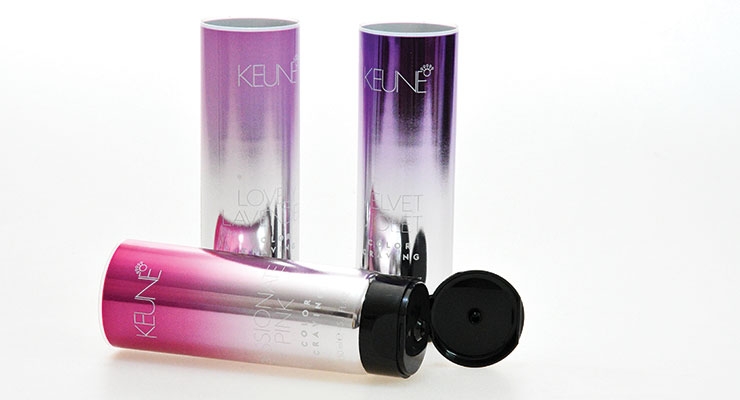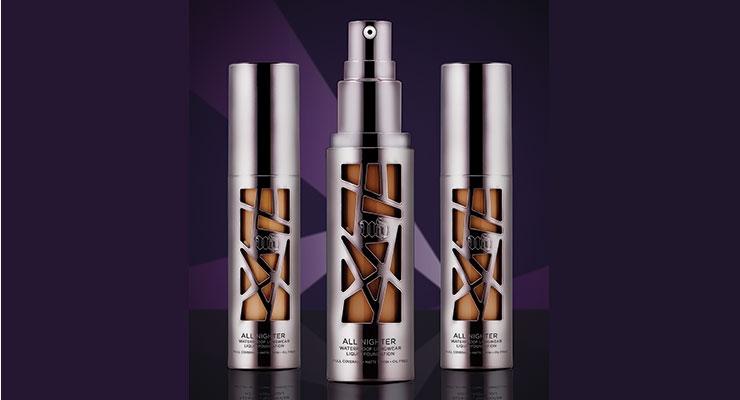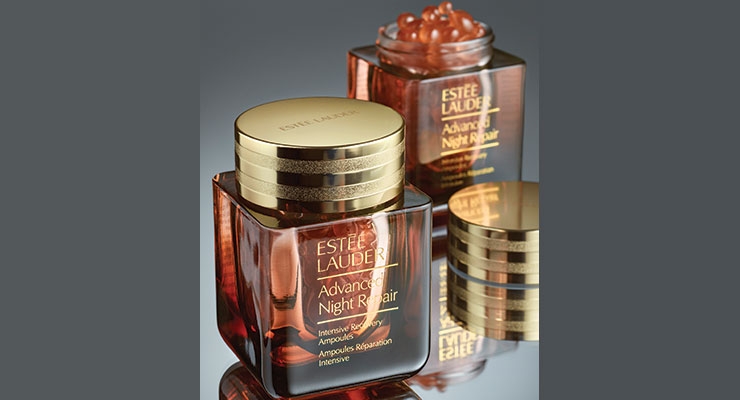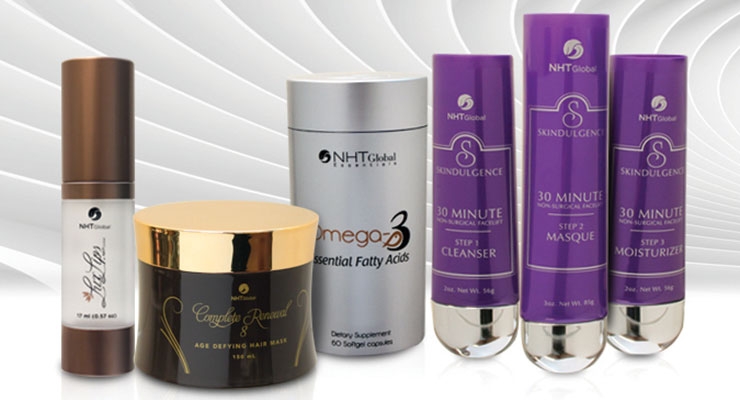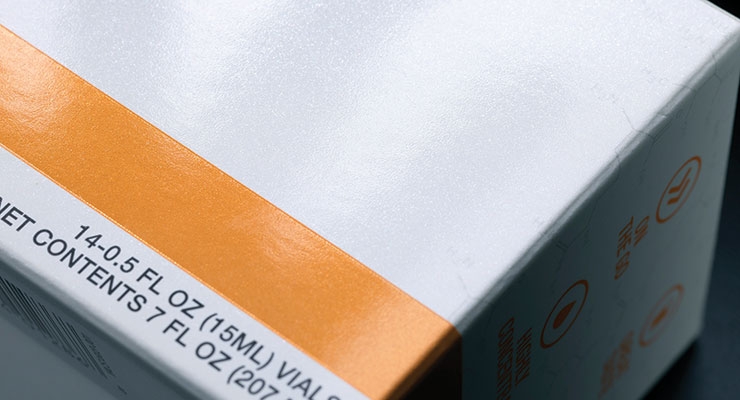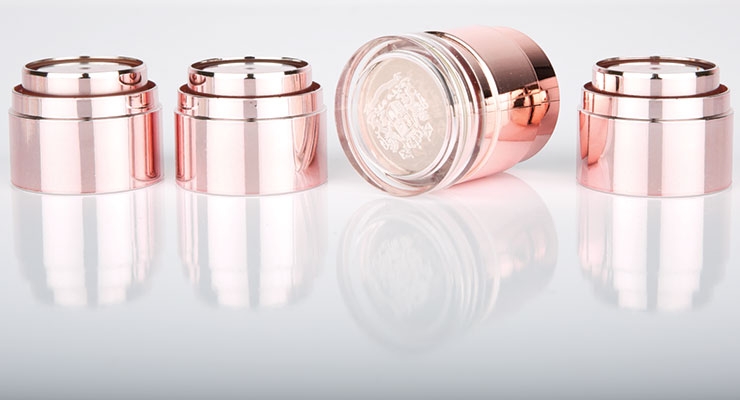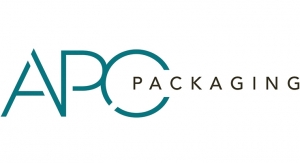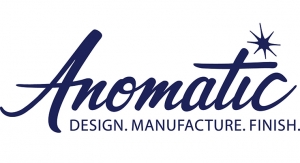Joanna Cosgrove, Contributing Editor12.05.16
Packaging is more than just utilitarian; it’s also made to feel good in the hand and look great at retail. Decorative details created using metallization, embossing or with specialty coatings go a long way toward helping brand cache, especially during the ultra-competitive holiday season.
Paul Uglum, board chairman, decoration and assembly division, Society of Plastics Engineers, says the hot deco trend right now is bright metallization–golds, silvers and combinations of colored metals—on labels and caps. “Shape, color, either complex or subtle like some of the anodized looks or bold solid colors (for men, blues and reds) would create better differentiation (especially if combined with a metallic cap),” he says.
When it comes to the current deco technology in the beauty segment, Uglum says the increase in Physical Vapor Deposition (PVD) and resulting metallic finishes has helped open the door for colored chrome appearances ranging from rich blacks to brighter colors. The combination of several decoration techniques in the same product package is another encouraging trend. He points to Decadence by Marc Jacobs as an example of a package that combines metallic accents and textured finishes in a tasteful way. But be careful, he warns. It’s easy to go overboard.
Uglum has observed a handful of deco trends in other industry segments that he believes would fit well within the beauty realm, including new uses of texture and tactile finish work. “Texture and the resulting shadow and tactile results can also be achieved with several processes including hydrographics and improved in-mold decoration techniques,” he says.
Mad for Metals
Metal has exciting chameleon-like duality in packaging circles. It can be rich and luxurious, imparting warmth and heft, or it can be cool and sleek, with a sparsely industrial, or edgy, futuristic vibe.
Alexander Kwapis, director of design and development at Fusion Packaging, Dallas, TX, says metallic effects continue to make a futuristic-meets-glamorous statement within the beauty industry. From gunmetal to rose gold in treatments ranging from shiny to matte, metallic accents can impart a range of effects on beauty packaging, and Fusion has been experimenting with the subtle differences between spray, UV metallization and anodization to help differentiate itself within the deco space.
“With the high demand for metallic effects and other trending decorations, we’re constantly updating our techniques using innovative finishes, which transform our client’s products into bold statement pieces,” Kwapis says.
Fusion recently executed the bold, avant-garde bottle for Urban Decay’s All Nighter foundation, which features a highly UV metallized, gunmetal effect with asymmetric cutouts that lets the formula shade show through. The 30ml bottle is also outfitted with an airless pump that helps get every bit of product out. “Behind the overshell is a clarified clear polypropylene airless bottle that incorporates a multitude of benefits including contact clarity, which allows the user to see their foundation shade, great product preservation and evacuation that extends the shelf life,” Kwapis explains.
For New Albany, OH-based Anomatic, the metal deco trend is all about customization. “Customers don’t want off-the-shelf solutions anymore; they want to stand out from their competitors,” says the company’s Steve Rusch, vice president of marketing.
“At Anomatic, customized solutions increasingly involve printing, embossing and debossing, while metal tooling continues to be a popular trend for brand reinforcement.”
Rusch says emerging techniques include offset printing that allows for printing four colors on plastic or anodized aluminum. “We’re also trying to stay ahead of the market by offering an innovative process where we apply hot foil stamping to anodized aluminum, which nearly duplicates the look of double anodization,” he says. “This is a much more cost-effective approach, and results in a customized, bright foil finish on any type of anodized substrate, so if you have a matte finish on anodized aluminum and bright logo, it really pops.”
Another aspect of the customization trend is the combination of finishing techniques. Rusch says a prime example is the work Anomatic completed for Estée Lauder’s Advanced Night Repair Intensive Recovery Ampoules. “We built the metal tooling in-house at our Connecticut facility, then simultaneously stamped the jar covers and applied a stippling deco to the sidewalls 360 degrees around, all in the tooling press,” he explains. “We then anodized the jar covers in a custom gold, screen printed the Estée Lauder brand name on top, followed by assembling the plastic inserts to the decorated metal components through a fully automated inline machine. This enables us to get it to market in the customer’s timeframe without the need for secondary processes.”
Estée Lauder now employs the same technique on a second product line and Anomatic continues to produce the packaging for both lines.
In March, Decotech Inc., Englewood, NJ, launched a new prestige-quality metallization technology that successfully circumvents the limitations of traditional vacuum metallization for glass, plastic and aluminum packaging. “Traditional vacuum metallization has been around and unchanged for decades,” says the company’s Richard Engel Jr., president & COO. “Rather than enter the market with more of the same, we selected a modern metallization technology that uses silver rather than aluminum, and which allows for effects and finishes that are not possible with traditional vacuum metallization.”
The Decotech technology delivers a variety of looks, including translucent metallic and gradient fades and textures, as well as multiple metallic color combinations, opacities and effects on the same piece. In short, it has modernized the metallization process. “Current projects include both glass and plastic bottles and caps, many of which take advantage of the new looks available for the first time in North America,” Engel says. “And some clients are just happy to have a domestic prestige supplier of high-quality metallization rather than having to offshore the work and deal with all the hurdles that brings.”
What’s more, the company employs an eco-friendly, closed-loop waste management system in which waste generated by the system is returned to the material supplier and re-processed to create new raw materials. The feature dovetails with Decotech’s commitment to environmental sustainability and its documented Zero-Waste-to-Landfill policy.
APC Packaging, Ft. Lauderdale, FL, provided metallization and silk screen printing services to its client, NHT Global, not just to help their product stand out on shelf, but also to provide clear visual indicators between the brand’s product lines. “Their hair care products have a shiny gold look while the skin care products have shiny silver accents and the supplements are all in jars that have been given a matte silver outer spray on both the lid and the body,” says APC Packaging’s Jennie Crumpler, creative manager.
APC Packaging recently launched a new “hydro dipped” technique for wood grain containers and closures that Crumpler says takes metallization to the next level. “Hydrographics, also known as immersion printing or water transfer printing, is a unique method of applying printed designs to three-dimensional objects,” she says. “It gives us the ability to achieve full coverage of areas that traditional printing methods are not currently capable of.”
A water-soluble film contains the printed designs and once an activator is applied, the film dissolves and leaves the ink sitting on the surface of the water. A container or closure is then immersed into the water and the ink wraps around it, filling in all nooks and crannies missed by traditional printing methods. The item is then washed and sealed with a clear topcoat.
Totally Tubular
In the coming years, plastic tubes are expected to show the strongest growth in terms of materials used in cosmetics packaging, according to Iftach Shachar, global sales manager, LageenTubes of Israel. “This is due to the cost-effectiveness, good performance, reliable protection, color versatility, flexibility and easy transportation and storage,” he says.
The biggest trend in the tube segment continues to be 360-degree decorative printing.
LageenTubes’ latest tube decoration technology, MetallicPlast, delivers premium, 360-degree graphics on seamless tubes with the realistic appearance of metal. “With our new technology, which has unique capabilities combining hot stamping, flexo printing, silk screen-printing and varnishing all inline on the same printing platform, we created the state-of-the-art tubes for our customers—full tube decoration—allowing wide decoration capabilities with direct print,” says Shachar. “Cosmetic brands like Keune and John Frieda have launched their premium cosmetic brands with LageenTubes’ new decoration technology and have experienced enormous success.”
Sydney Owen, marketing coordinator, Essel Propack Americas, LLC, Danville, VA, agrees with the impact of 360-degree tube deco, adding that there are several technologies that enable companies to take full advantage of a tube’s entire print area, including flexographic printing, rotary screen deco, and hot stamping and cold stamping with foil, all of which Essel Propack offers.
Owen says one of Essel Propack’s most recent beauty tube launches was L’Oréal Sublime Bronze Summer Express, which incorporated flexographic printing and a clear matte varnish coating.
“It’s a 34.1mm diameter tube with a special side seam [that had] 3.5mm void of print area,” she explains. “The tube also features an added rotary screen white technique for increased text readability on a red-brown background. “Fine Text printing was achieved with a special rotary screen material from Gallus SCREENY. To achieve the desired effect, we did offline color drawdowns before going on press to ensure we had locked in the color pallete [and], various gradient combinations were tested for smooth vignettes.”
Captivating Cartons
Folding cartons create a buzz when they feature decorative print and finishing techniques. Cartons can be especially high-impact when they incorporate a unique decorating effect such as lenticular printing.
Lenticular printing is achieved by essentially layering flat images to convey movement and depth. “A plastic sheet covers the image with tiny strategically placed slits so the ridges allow for the eye to catch each image from different angles,” explains Olanrewaju Lanre Olotu, president, Olotu Packaging International Inc. (OPI), Rochester, NY, a provider of lenticular printing.
OPI’s pre-press team begins the lenticular creation process by cutting images into strips then weaving images together. “Digital technology makes this an automatic process, but specific designs require custom builds,” he says, adding that there are two primary effects gleaned from lenticular printing, animation and three-dimensional (3-D) viewing.
“Pearling” a carton also adds panache, especially in the beauty segment. Olotu says a recent OPI client sought packaging for a new line, with a focus on maintaining brand identity and continuity, while keeping within their desired price point. To that end, all the materials, designs, and embellishments for the packaging were designed to deliver a luxurious look and feel without exceeding the customer’s budget. OPI achieved this by leveraging unique press capabilities to combine multiple finishes and textures in just two printing passes.
“The subtle, pearlized finish, silver foil stamping, and perfectly registered embossing of the logo and brand name lend this piece an elegance which stands out against many of the more brightly appointed packages on the shelf,” Olotu says. “The finished packaging is a perfect complement to the client’s current brand identity, and is in line with what consumers expect from products at a higher price point. The result is a prestige piece that has a high-end look and feel, yet is still cost-effective.”
Packaging plays an essential role in the beauty and personal care market and decorative embellishments help contribute to a brand’s unique identity. “As more and more competition enters the marketplace, companies are being challenged to find new and unique ways to make their products into attention grabbers on store shelves,” concludes APC Packaging’s Crumpler. “Companies rely on the different coatings, finishes and embellishments offered to help transform their ordinary packaging into extraordinary packaging.”
Equipment suppliers are instrumental in developing new technologies for packaging suppliers to execute decorating effects that were once considered unthinkable, both from a technological and an environmental standpoint. As a manufacturer of coating, metallization and digital printing equipment, Tony Denning, president, Tapematic USA, Orlando, FL, says the direction now is toward combining technologies. “For example, when you combine digital printing (CPrint/TPrint) prior to coating and metallization you can achieve some interesting effects, primarily digital embossing when the surface below the metallization is raised by the digital print below,” he says. “This allows you to customize either large production runs or short runs of the same object with different digital embossing which in turn provides a unique look and feel. Another example would be to use a standard cap and have different designs and textures without the need to re-tool.”
Streamlining the manufacturing process is also critical. Tapematic’s PST Line is an example of how the company developed equipment to meet that requirement. “Traditionally objects that require metallization are produced in batch form, meaning hundreds or thousands of objects are loaded onto racks and then placed into a large chamber, and then high vacuum is generated which takes a considerable time, up to 10-15 minutes,” Denning explains, noting that these systems are historically unfriendly to the environment; tending to use 100kW of power or more. “The PST Line only uses 30kW, a massive savings not only for the cost but also for the impact on the environment.
“Another factor is the VOC emissions the traditional coating/varnishing/paint lines use—not only are they considered inefficient compared with today’s technology, they tend to have high VOC emissions,” he says. “The PST Line uses UV varnishes which can be up to 100% solids, meaning very low VOC emissions. At the end of the day, brands need to consider how and where their decoration is done and the social and environmental impact their product has.”
Paul Uglum, board chairman, decoration and assembly division, Society of Plastics Engineers, says the hot deco trend right now is bright metallization–golds, silvers and combinations of colored metals—on labels and caps. “Shape, color, either complex or subtle like some of the anodized looks or bold solid colors (for men, blues and reds) would create better differentiation (especially if combined with a metallic cap),” he says.
When it comes to the current deco technology in the beauty segment, Uglum says the increase in Physical Vapor Deposition (PVD) and resulting metallic finishes has helped open the door for colored chrome appearances ranging from rich blacks to brighter colors. The combination of several decoration techniques in the same product package is another encouraging trend. He points to Decadence by Marc Jacobs as an example of a package that combines metallic accents and textured finishes in a tasteful way. But be careful, he warns. It’s easy to go overboard.
Uglum has observed a handful of deco trends in other industry segments that he believes would fit well within the beauty realm, including new uses of texture and tactile finish work. “Texture and the resulting shadow and tactile results can also be achieved with several processes including hydrographics and improved in-mold decoration techniques,” he says.
Mad for Metals
Metal has exciting chameleon-like duality in packaging circles. It can be rich and luxurious, imparting warmth and heft, or it can be cool and sleek, with a sparsely industrial, or edgy, futuristic vibe.
Alexander Kwapis, director of design and development at Fusion Packaging, Dallas, TX, says metallic effects continue to make a futuristic-meets-glamorous statement within the beauty industry. From gunmetal to rose gold in treatments ranging from shiny to matte, metallic accents can impart a range of effects on beauty packaging, and Fusion has been experimenting with the subtle differences between spray, UV metallization and anodization to help differentiate itself within the deco space.
“With the high demand for metallic effects and other trending decorations, we’re constantly updating our techniques using innovative finishes, which transform our client’s products into bold statement pieces,” Kwapis says.
Fusion recently executed the bold, avant-garde bottle for Urban Decay’s All Nighter foundation, which features a highly UV metallized, gunmetal effect with asymmetric cutouts that lets the formula shade show through. The 30ml bottle is also outfitted with an airless pump that helps get every bit of product out. “Behind the overshell is a clarified clear polypropylene airless bottle that incorporates a multitude of benefits including contact clarity, which allows the user to see their foundation shade, great product preservation and evacuation that extends the shelf life,” Kwapis explains.
For New Albany, OH-based Anomatic, the metal deco trend is all about customization. “Customers don’t want off-the-shelf solutions anymore; they want to stand out from their competitors,” says the company’s Steve Rusch, vice president of marketing.
“At Anomatic, customized solutions increasingly involve printing, embossing and debossing, while metal tooling continues to be a popular trend for brand reinforcement.”
Rusch says emerging techniques include offset printing that allows for printing four colors on plastic or anodized aluminum. “We’re also trying to stay ahead of the market by offering an innovative process where we apply hot foil stamping to anodized aluminum, which nearly duplicates the look of double anodization,” he says. “This is a much more cost-effective approach, and results in a customized, bright foil finish on any type of anodized substrate, so if you have a matte finish on anodized aluminum and bright logo, it really pops.”
Another aspect of the customization trend is the combination of finishing techniques. Rusch says a prime example is the work Anomatic completed for Estée Lauder’s Advanced Night Repair Intensive Recovery Ampoules. “We built the metal tooling in-house at our Connecticut facility, then simultaneously stamped the jar covers and applied a stippling deco to the sidewalls 360 degrees around, all in the tooling press,” he explains. “We then anodized the jar covers in a custom gold, screen printed the Estée Lauder brand name on top, followed by assembling the plastic inserts to the decorated metal components through a fully automated inline machine. This enables us to get it to market in the customer’s timeframe without the need for secondary processes.”
Estée Lauder now employs the same technique on a second product line and Anomatic continues to produce the packaging for both lines.
In March, Decotech Inc., Englewood, NJ, launched a new prestige-quality metallization technology that successfully circumvents the limitations of traditional vacuum metallization for glass, plastic and aluminum packaging. “Traditional vacuum metallization has been around and unchanged for decades,” says the company’s Richard Engel Jr., president & COO. “Rather than enter the market with more of the same, we selected a modern metallization technology that uses silver rather than aluminum, and which allows for effects and finishes that are not possible with traditional vacuum metallization.”
The Decotech technology delivers a variety of looks, including translucent metallic and gradient fades and textures, as well as multiple metallic color combinations, opacities and effects on the same piece. In short, it has modernized the metallization process. “Current projects include both glass and plastic bottles and caps, many of which take advantage of the new looks available for the first time in North America,” Engel says. “And some clients are just happy to have a domestic prestige supplier of high-quality metallization rather than having to offshore the work and deal with all the hurdles that brings.”
What’s more, the company employs an eco-friendly, closed-loop waste management system in which waste generated by the system is returned to the material supplier and re-processed to create new raw materials. The feature dovetails with Decotech’s commitment to environmental sustainability and its documented Zero-Waste-to-Landfill policy.
APC Packaging, Ft. Lauderdale, FL, provided metallization and silk screen printing services to its client, NHT Global, not just to help their product stand out on shelf, but also to provide clear visual indicators between the brand’s product lines. “Their hair care products have a shiny gold look while the skin care products have shiny silver accents and the supplements are all in jars that have been given a matte silver outer spray on both the lid and the body,” says APC Packaging’s Jennie Crumpler, creative manager.
APC Packaging recently launched a new “hydro dipped” technique for wood grain containers and closures that Crumpler says takes metallization to the next level. “Hydrographics, also known as immersion printing or water transfer printing, is a unique method of applying printed designs to three-dimensional objects,” she says. “It gives us the ability to achieve full coverage of areas that traditional printing methods are not currently capable of.”
A water-soluble film contains the printed designs and once an activator is applied, the film dissolves and leaves the ink sitting on the surface of the water. A container or closure is then immersed into the water and the ink wraps around it, filling in all nooks and crannies missed by traditional printing methods. The item is then washed and sealed with a clear topcoat.
Totally Tubular
In the coming years, plastic tubes are expected to show the strongest growth in terms of materials used in cosmetics packaging, according to Iftach Shachar, global sales manager, LageenTubes of Israel. “This is due to the cost-effectiveness, good performance, reliable protection, color versatility, flexibility and easy transportation and storage,” he says.
The biggest trend in the tube segment continues to be 360-degree decorative printing.
LageenTubes’ latest tube decoration technology, MetallicPlast, delivers premium, 360-degree graphics on seamless tubes with the realistic appearance of metal. “With our new technology, which has unique capabilities combining hot stamping, flexo printing, silk screen-printing and varnishing all inline on the same printing platform, we created the state-of-the-art tubes for our customers—full tube decoration—allowing wide decoration capabilities with direct print,” says Shachar. “Cosmetic brands like Keune and John Frieda have launched their premium cosmetic brands with LageenTubes’ new decoration technology and have experienced enormous success.”
Sydney Owen, marketing coordinator, Essel Propack Americas, LLC, Danville, VA, agrees with the impact of 360-degree tube deco, adding that there are several technologies that enable companies to take full advantage of a tube’s entire print area, including flexographic printing, rotary screen deco, and hot stamping and cold stamping with foil, all of which Essel Propack offers.
Owen says one of Essel Propack’s most recent beauty tube launches was L’Oréal Sublime Bronze Summer Express, which incorporated flexographic printing and a clear matte varnish coating.
“It’s a 34.1mm diameter tube with a special side seam [that had] 3.5mm void of print area,” she explains. “The tube also features an added rotary screen white technique for increased text readability on a red-brown background. “Fine Text printing was achieved with a special rotary screen material from Gallus SCREENY. To achieve the desired effect, we did offline color drawdowns before going on press to ensure we had locked in the color pallete [and], various gradient combinations were tested for smooth vignettes.”
Captivating Cartons
Folding cartons create a buzz when they feature decorative print and finishing techniques. Cartons can be especially high-impact when they incorporate a unique decorating effect such as lenticular printing.
Lenticular printing is achieved by essentially layering flat images to convey movement and depth. “A plastic sheet covers the image with tiny strategically placed slits so the ridges allow for the eye to catch each image from different angles,” explains Olanrewaju Lanre Olotu, president, Olotu Packaging International Inc. (OPI), Rochester, NY, a provider of lenticular printing.
OPI’s pre-press team begins the lenticular creation process by cutting images into strips then weaving images together. “Digital technology makes this an automatic process, but specific designs require custom builds,” he says, adding that there are two primary effects gleaned from lenticular printing, animation and three-dimensional (3-D) viewing.
“Pearling” a carton also adds panache, especially in the beauty segment. Olotu says a recent OPI client sought packaging for a new line, with a focus on maintaining brand identity and continuity, while keeping within their desired price point. To that end, all the materials, designs, and embellishments for the packaging were designed to deliver a luxurious look and feel without exceeding the customer’s budget. OPI achieved this by leveraging unique press capabilities to combine multiple finishes and textures in just two printing passes.
“The subtle, pearlized finish, silver foil stamping, and perfectly registered embossing of the logo and brand name lend this piece an elegance which stands out against many of the more brightly appointed packages on the shelf,” Olotu says. “The finished packaging is a perfect complement to the client’s current brand identity, and is in line with what consumers expect from products at a higher price point. The result is a prestige piece that has a high-end look and feel, yet is still cost-effective.”
Packaging plays an essential role in the beauty and personal care market and decorative embellishments help contribute to a brand’s unique identity. “As more and more competition enters the marketplace, companies are being challenged to find new and unique ways to make their products into attention grabbers on store shelves,” concludes APC Packaging’s Crumpler. “Companies rely on the different coatings, finishes and embellishments offered to help transform their ordinary packaging into extraordinary packaging.”
Equipment suppliers are instrumental in developing new technologies for packaging suppliers to execute decorating effects that were once considered unthinkable, both from a technological and an environmental standpoint. As a manufacturer of coating, metallization and digital printing equipment, Tony Denning, president, Tapematic USA, Orlando, FL, says the direction now is toward combining technologies. “For example, when you combine digital printing (CPrint/TPrint) prior to coating and metallization you can achieve some interesting effects, primarily digital embossing when the surface below the metallization is raised by the digital print below,” he says. “This allows you to customize either large production runs or short runs of the same object with different digital embossing which in turn provides a unique look and feel. Another example would be to use a standard cap and have different designs and textures without the need to re-tool.”
Streamlining the manufacturing process is also critical. Tapematic’s PST Line is an example of how the company developed equipment to meet that requirement. “Traditionally objects that require metallization are produced in batch form, meaning hundreds or thousands of objects are loaded onto racks and then placed into a large chamber, and then high vacuum is generated which takes a considerable time, up to 10-15 minutes,” Denning explains, noting that these systems are historically unfriendly to the environment; tending to use 100kW of power or more. “The PST Line only uses 30kW, a massive savings not only for the cost but also for the impact on the environment.
“Another factor is the VOC emissions the traditional coating/varnishing/paint lines use—not only are they considered inefficient compared with today’s technology, they tend to have high VOC emissions,” he says. “The PST Line uses UV varnishes which can be up to 100% solids, meaning very low VOC emissions. At the end of the day, brands need to consider how and where their decoration is done and the social and environmental impact their product has.”

